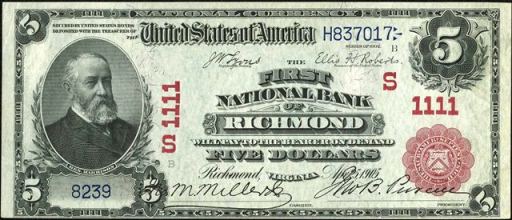The First National Bank Of Sykesville
The First National Bank Of Sykesville in Maryland printed $28,500 dollars worth of national currency. In the scheme of things, that is a very tiny output. Notes from this bank should be rare. This national bank opened in 1907 and stopped printing money in 1913, which equals a 7 year printing period. That is obviously a very short period of time. During its life, The First National Bank Of Sykesville issued 4 different types and denominations of national currency. We have examples of the types listed below. Your bank note should look similar. Just the bank name will be different. For the record, The First National Bank Of Sykesville was located in Carroll County. It was assigned charter number 8578.
We buy all national currency. Please call or email us for a quote. Sales@AntiqueMoney.com
The First National Bank Of Sykesville in Maryland printed 160 sheets of $5 1902 red seal national bank notes. All red seals are very rare. But that sheet output is extremely low. We would love to see a picture of what you have. Five dollar red seals are typically a little bit rarer than some higher denominations. That rarity is typically just a result of small issuances. Most national banks preferred to issue $10 and $20 1902 red seals. Each one of these five dollar bank notes has a portrait of Ben Harrison on the left hand side of the bill. Most people are quick to notice the cursive charter date with a year between 1902 and 1908 written on it. That date will never affect the value.
1902 $5 Red Seal National Bank Note
The First National Bank Of Sykesville printed 160 sheets of $10 1902 red seal national bank notes. All red seals are very rare. But that sheet output is extremely low. We would love to see a picture of what you have. Collectors love ten dollar 1902 red seals. They usually represent the rarest bank notes printed by any national bank. Don’t let the term “series of 1902” confuse you. These were actually printed for about six years between 1902 and 1908. That is obviously a very short issue period which means that many red seals are quite rare. Each note has a portrait of William McKinley. Be sure to check the number under McKinley. If it is #1 then you are dealing with a note from the first sheet of bank notes issued. Number one bank notes are worth even more money than the already rare red seals.
1902 $10 Red Seal National Bank Note
The First National Bank Of Sykesville also printed 331 sheets of $5 1902 blue seal national bank notes. In the scheme of things that is a really tiny printing number. You are likely dealing with a true rarity. Ben Harrison is on the front of all 1902 $5 blue seal bank notes. This happens to be the smallest denomination issued for the 1902 series. Each note is complete with a blue seal and blue charter number. Despite saying series of 1902, these were actually issued by national banks between 1908 and 1928. There are two different types of blue seals. The first type is called a date back and it has “1902-1908” written on the back of the bill. The other type is called a plain back; it does not have the date stamps on the back of the bill. The values for these notes range widely based on condition and the bank of issue.
1902 $5 Blue Seal National Bank Note
The First National Bank Of Sykesville also printed 307 sheets of $10 1902 blue seal national bank notes. In the scheme of things that is a really tiny printing number. You are likely dealing with a true rarity. 1902 $10 blue seal bank notes all have a portrait of William McKinley on them. Values can range from as little as $40 up to over $10,000. There really is no trick to know what is rare and what is common by just doing an internet search. You really need to work with an expert (like us) in order to determine the value of your specific bank note. There are at least ten different factors than can make some 1902 $10 blue seals worth more than others. We know exactly what to look for and we would be happy to provide a free appraisal and our best offer.
1902 $10 Blue Seal National Bank Note



